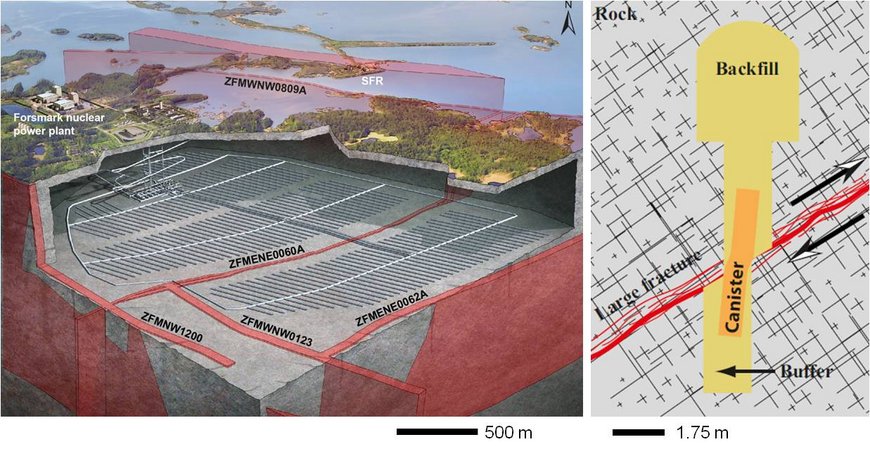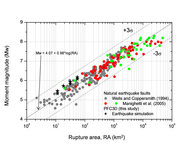ThermoQuakes
ThermoQuakes 3D thermo-mechanical modelling of seismicity related to the final disposal of spent nuclear fuel and radioactive waste in hard rock (SSM, 2015-2017)
Time frame: 2015 - 2017
Funding: Swedish Radiation Authority (Strål Säkerhets Myndigheten - SSM)
Principal InvestigatorsA. Zang, GFZ, Section 2.6, Germany
Personnel: Jeoung Seok Yoon, GFZ Section 2.6, Germany
The Swedish Radiation Authority (SSM - Strålsäkerhetsmyndigheten) is the Swedish regulator for the process to build a deep geological repository for high-level radioactive waste. For the selected site Forsmark we model the impact of thermal and earthquake loads on the naturally fractured crystalline rock mass surrounding the repository and their association with complex geologic structures. Besides the thermo-mechanical processes the model can also simulate the induced seismic events (TM-D model) from dynamic rupturing as well as those arising from dissipation of the energy in form of seismic waves.
To be able to assess the safety of a repository for radioactive waste and spent nuclear fuel, it is necessary to consider all possible threats that could impair the physical integrity of the barriers. One environmental threat is an earthquake occurring at nearby faults, and the effect of an earthquake relevant to the repository safety is the shear displacement of rock fractures induced by an earthquake event occurring at nearby large faults (Fig.1).
In this project, we use 3D discrete element based thermo-mechanical coupled dynamic modelling to investigate the safety of the repository at Forsmark Sweden for final disposal of spent nuclear fuels. Especially, we investigate the impacts of larger magnitude (M>6) earthquakes that could occur in the next few hundred years near the Forsmark site. Followings are the objectives of the project.
- Generation of bonded-particle based 3D geological model of Forsmark repository site with heterogeneously represented geological discontinuities, e.g. faults and fractures
- Development of a numerical workflow for simulation of fault dynamic rupture (Yoon et al. 2014, 2017)
- Investigation of impacts of radioactive decaying heat to the repository fracture system (Yoon et al. 2016)
- Investigation of impacts of earthquake events to the repository fracture system (Fig.2)
- Verification and validation of the simulated earthquake against earthquake fault scaling relation (Fig.3)
Fig.2. Temporal change of the slip (in meter) distribution of a dynamically rupturing fault. The co-seismic slip concentrates at one point on the fault plane and propagates outward, which results in asymmetric and heterogeneous slip profiles. Black dots are the deposition holes. (Click for animation)
Publications/Results
- Yoon JS, Stephansson O, Zang A, Min KB, Lanaro F (2017), Discrete bonded particle modelling of fault activation near a nuclear waste repository site and comparison to static rupture earthquake scaling laws, Int J Rock Mech Min Sci, 98, 1-9, http://dx.doi.org/10.1016/j.ijrmms.2017.07.008
- Yoon JS, Stephansson O, Zang A, Min KB, Lanaro F (2016), Numerical modelling of earthquakes and induced seismicity under various in situ stress conditions at Forsmark, Sweden, the site for a final repository of spent nuclear fuel, RS2016 Symposium – 7th International Symposium on In-Situ Rock Stress, May 10-12, 2016, Tampere, Finland.
- Yoon JS, Stephansson O, Min KB (2016), Modelling of the thermal evolution of the KBS-3 repository at Forsmark and associated induced seismic activity, Technical Note 2016:23, Swedish Radiation Safety Authority. http://www.stralsakerhetsmyndigheten.se/Publikationer/Rapport/Avfall-transport-fysiskt-skydd/2016/201623-Technical-Note-Modelling-of-the-thermal-evolution-of-the-KBS-3-repository-at-Forsmark-and-associated-induced-seismic-activity/
- Yoon JS, Stephansson O, Min KB (2014), Relation between earthquake magnitude, fracture length and fracture shear displacement in the KBS-3 repository at Forsmark, Technical Note 2014:59, Swedish Radiation Safety Authority. http://www.stralsakerhetsmyndigheten.se/Publikationer/Rapport/Avfall-transport-fysiskt-skydd/2014/201459/






